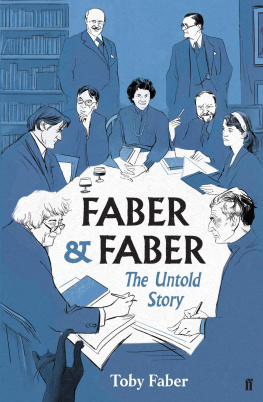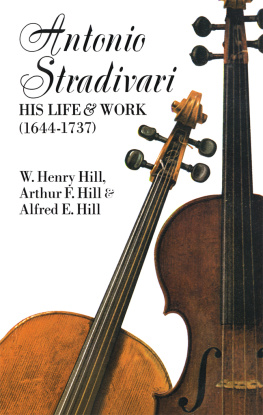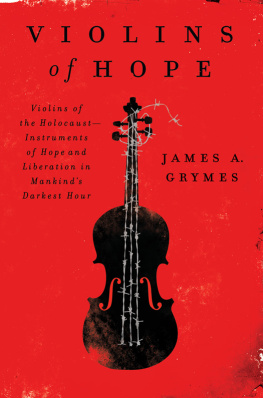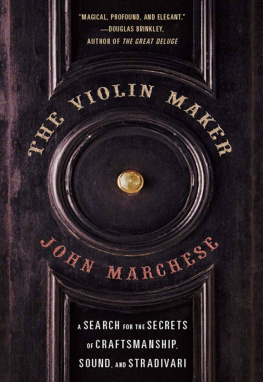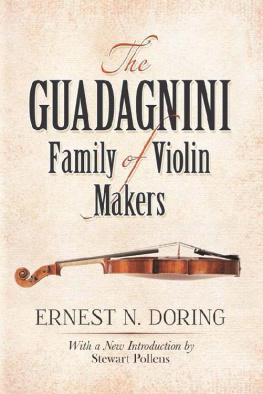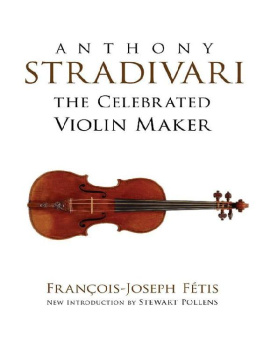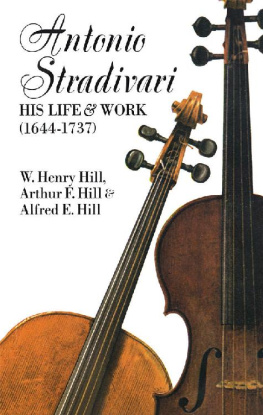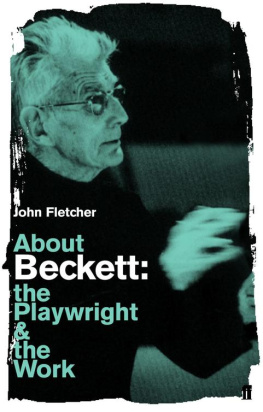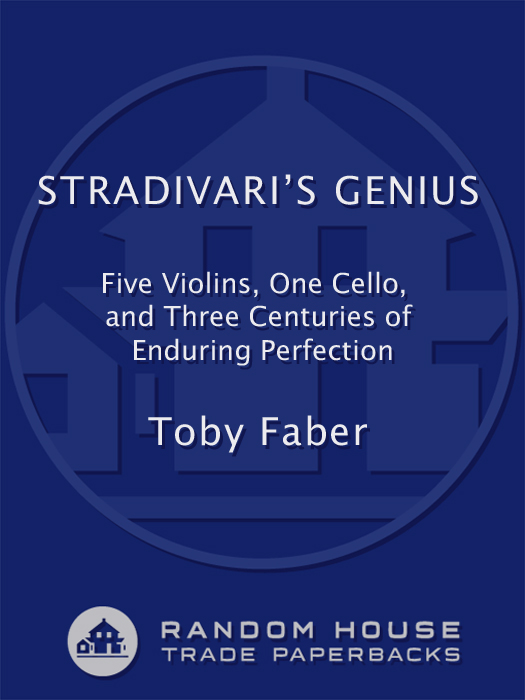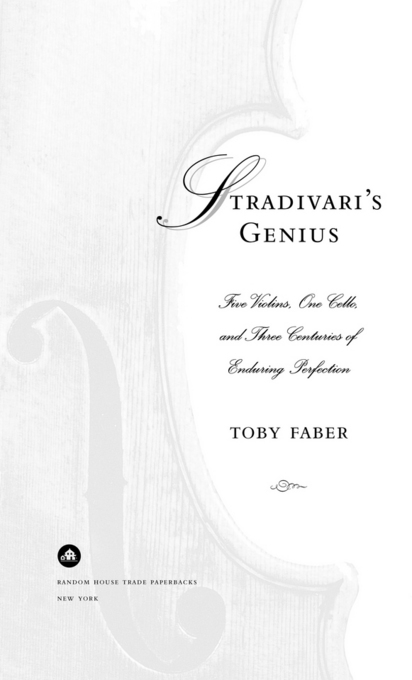PRAISE FOR
STRADIVARIS GENIUS
The real delight of Mr. Fabers book lies in his decision to tell the Stradivari story through the lives of six of the masters best-known instruments.
The Economist
Enthralling and accessible.
Booklist
Fabers stylish account savors Stradivaris marvelous acoustics and the individual personalities of his instruments while exploring the science behind them (X-rays, chemical tests and tree-ring analysis have all been deployed to unlock their secrets) and regaling readers with colorful tales of the musicians who built their careers around them. The result is an illuminating look at an enduring cultural monument.
Publishers Weekly
A captivating account of the often tangled histories of six celebrated Stradivarius instruments Especially impressive is Fabers depth of research. Highly recommended.
Library Journal (starred review)
Lovingly researched [Faber] is able to let the evolution of the violin unfold before us.
The Sunday Times (London)
Stradivari, said Paganini, used only wood from trees on which nightingales sang. That flight of fancy typifies the reverence which these instruments still inspire, and that reverence pervades Toby Fabers knowledgeable study of the Strads, sharpened by scholarship and a keen eye for an anecdote.
Literary Review
These stories Faber weaves seamlessly together, in prose of admirable lucidity. [He] pitches his story just right, neither patronizing nor baffling the reader.
The Times (London)
Faber is chatty, user-friendly, eagerly non-elitist, and minimizing of sources, yet his passion for his subject, his painstaking research, his faith in the integrity of musicianship and craftsmanship lifts this book above gossip for the string-playing classes. Fabers observations are always illuminating.
Financial Times
Even the most straightforward biography of Antonio Stradivari, the virtuoso instrument-maker whose craftsmanship to this day baffles scientists and musicians alike, would make for a gripping read. But Toby Faber is far too restless and instinctive a storyteller to be content with a single time or place. His is more of a quest across centuries and continents in search of elusive treasures rather than a conventional life. It is fascinating to follow his passionate pursuit of the Davidov, a cello currently in hands of Yo-Yo Ma, and five violins, including the fabled Messiah. Faber keeps the many separate strings of his story in harmony.
The Observer
Stradivarius is an inspired idea for a book. Because these instruments and their players have reputations that have endured, Faber has been able to find fine tales that hang on each of them. Unlike so many books of this sort, which focus on small things and pan out into world history, Faber has needed no padding or special pleading. Best of all, he remains clear-headed about his subject.
The Daily Telegraph
2006 Random House Trade Paperback Edition
Copyright 2004 by Toby Faber
All rights reserved.
Published in the United States by Random House Trade Paperbacks, an imprint of The Random House Publishing Group, a division of Random House, Inc., New York.
R ANDOM H OUSE T RADE P APERBACKS and colophon are trademarks of Random House, Inc.
This work was originally published in the United Kingdom in 2004 as Stradivarius: Five Violins, One Cello and a Genius by Macmillan UK, and in hardcover in the United States by Random House, an imprint of The Random House Publishing Group, a division of Random House, Inc., in 2005.
Grateful acknowledgment is made to The New York Times for permission to reprint a brief excerpt from an article entitled Davidoff Cello Arrives on Paris from the November 29, 1928 issue of The New York Times, copyright 1928 by The New York Times Co. Reprinted by permission.
eISBN: 978-1-58836-214-8
www.atrandom.com
v3.1
T o
my mother, Penny,
my wife, Amanda,
and
my daughter, Lucy
CONTENTS
Chapter One
F IVE VIOLINS AND ONE CELLO
The Messiah, the Viotti, the Khevenhller, the Paganini, the Lipiski, and the Davidov
Chapter Two
T HE INCOMPARABLY BETTER VIOLINS OF C REMONA
The Amati dynasty
Chapter Three
H E WAS A GENIUS ALREADY
The origins and development of Antonio Stradivari
Chapter Four
H IS COSTUME SCARCELY EVER VARIED
Stradivaris golden period, decline, and death
Chapter Five
S O SINGULAR AND SO BEAUTIFUL
The violins of Giuseppe Tartini and Paolo Stradivari
Chapter Six
M Y VIOLIN SHOULD REALIZE A LARGE SUM
Viotti and his Strad
Chapter Seven
T O THE V IRTUOSOS OF V IOLINS
Prince Khevenhller, Count Cozio, Joseph Bhm, and Tarisio
Chapter Eight
T HE TURNING-POINT IN THE HISTORY OF VIRTUOSITY
Paganini, showman and dealer
Chapter Nine
I HAVE 80,000 FRANCS ON ME
Vuillaume and the Hotel of Delights
Chapter Ten
U NVEILED IN ALL ITS INTACT GLORY
The Messiah makes its mark
Chapter Eleven
F IND HIS MAJESTYS SOLOIST
Charles Davidov and his cello
Chapter Twelve
A N IMMENSE RESERVE OF STRENGTH
Marie Hall, the Hills, and the Edwardian era
Chapter Thirteen
N O MATTER WHAT THE PRICE
Four Strads go to America
Chapter Fourteen
W HAT CAN WE SELL THIS AS ?
Violin dealers and the postwar world
Chapter Fifteen
T HE SOUND KEPT ON COMING AND COMING
The Davidov, the Paganini, the Khevenhller, the Viotti and the Marie Hall
Chapter Sixteen
A RUN-OF-THE-MILL S TRAD
Interpreting the Messiah

Violins are the lively, forward, importunate wits, that distinguish themselves by the Flourishes of Imagination, Sharpness of Repartee, Glances of Satyr, and bear away the upper Part in every Consort. I cannot however but observe, that when a Man is not disposd to hear Musick, there is not a more disagreeable Sound in Harmony than that of a Violin.
THE TATLER , APRIL 1, 1710
I have a violin that was born in 1713. It was alive long before me, and I hope it lives long after me. I dont consider it as my violin. Rather, I am perhaps its violinist; I am passing through its life.
IVRY GITLIS, THE ART OF VIOLIN, 2000
A great violin is alive; its very shape embodies its makers intentions, and its wood stores the history, or the soul, of its successive owners. I never play without feeling that I have released or, alas, violated spirits




